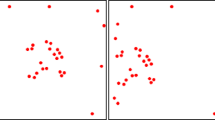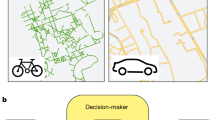Abstract
Performance on a typical pen-and-paper (figural) version of the Traveling Salesman Problem was compared to performance on a room-sized navigational version of the same task. Nine configurations were designed to examine the use of the nearest-neighbor (NN), cluster approach, and convex-hull strategies. Performance decreased with an increasing number of nodes internal to the hull, and improved when the NN strategy produced the optimal path. There was no overall difference in performance between figural and navigational task modalities. However, there was an interaction between modality and configuration, with evidence that participants relied more heavily on the NN strategy in the figural condition. Our results suggest that participants employed similar, but not identical, strategies when solving figural and navigational versions of the problem. Surprisingly, there was no evidence that participants favored global strategies in the figural version and local strategies in the navigational version.





Similar content being viewed by others
References
Best, B. J. (2006). Modeling human performance on the traveling salesman problem: empirical studies and computational simulations. USA: ProQuest Information and Learning.
Blaser, R., & Ginchansky, R. (2012). Route selection by rats and humans in a navigational traveling salesman problem. Animal Cognition, 15(2), 239–250.
Bures, J., Buresova, O., & Nerad, L. (1992). Can rats solve a simple version of the traveling salesman problem? Behavioural Brain Research, 52(2), 133–142.
Cramer, A., & Gallistel, C. (1997). Vervet monkeys as travelling salesmen. Nature, 387, 464.
Gärling, T. (1989). The role of cognitive maps in spatial decisions. Journal of Environmental Psychology, 9(4), 269–278.
Gibson, B. M., Wasserman, E. A., & Kamil, A. C. (2007). Pigeons and people select efficient routes when solving a one-way ‘traveling salesperson’ task. Journal of Experimental Psychology: Animal Behavior Processes, 33(3), 244–261.
Gibson, B., Wilkinson, M., & Kelly, D. (2012). Let the pigeon drive the bus: pigeons can plan future routes in a room. Animal Cognition, 15(3), 379–391.
Golden, B., Bodin, L., Doyle, T., & Stewart, W, Jr. (1980). Approximate traveling salesman algorithms. Operations Research, 28(3 Part-II), 694–711.
Graham, S. M., Joshi, A., & Pizlo, Z. (2000). The traveling salesman problem: a hierarchical model. Memory Cognition, 28(7), 1191–1204.
Kong, X., & Schunn, C. D. (2007). Global vs. local information processing in visual/spatial problem solving: the case of traveling salesman problem. Cognitive Systems Research, 8(3), 192–207.
MacGregor, J. N., Chronicle, E. P., & Ormerod, T. C. (2004). Convex hull or crossing avoidance? Solution heuristics in the traveling salesperson problem. Memory Cognition, 32(2), 260–270.
MacGregor, J. N., & Chu, Y. (2011). Human performance on the traveling salesman and related problems: a review. The Journal of Problem Solving, 3(2), 1–29. (article 2).
MacGregor, J. N., & Ormerod, T. (1996). Human performance on the traveling salesman problem. Perception and Psychophysics, 58(4), 527–539.
MacGregor, J. N., & Ormerod, T. C. (2000). Evaluating the importance of the convex hull in solving the Euclidean version of the traveling salesperson problem: reply to Lee and Vickers. Perception and Psychophysics, 62(7), 1501–1503.
MacGregor, J. N., Ormerod, T. C., & Chronicle, E. P. (1999). Spatial and contextual factors in human performance on the traveling salesperson problem. Perception, 28, 1417–1427.
MacGregor, J. N., Ormerod, T. C., & Chronicle, E. P. (2000). A model of human performance on the traveling salesperson problem. Memory Cognition, 28(7), 1183–1190.
Menzel, E. W. (1973). Chimpanzee spatial memory organization. Science, 182(4115), 943–945.
Miyata, H., & Fujita, K. (2010). Route selection by pigeons (Columba livia) in “traveling salesperson” navigation tasks presented on an LCD screen. Anglais, 124(4), 433–446.
Miyata, H., Ushitani, T., Adachi, I., & Fujita, K. (2006). Performance of pigeons (Columba livia) on maze problems presented on the LCD screen: in search for preplanning ability in an avian species. Anglais, 120(4), 358–366.
Montello, D. (1993). Scale and multiple psychologies of space. Spatial information theory a theoretical basis for GIS. In: A. Frank, I. Campari (Eds.), Lecture notes in computer science vol 716. (pp. 312–321). Berlin/Heidelberg: Springer. doi:10.1007/3-540-57207-4_21.
Ormerod, T. C., & Chronicle, E. P. (1999). Global perceptual processing in problem solving: the case of the traveling salesperson. Perception and Psychophysics, 61(6), 1227–1238.
Pizlo, Z., Stefanov, E., Saalweachter, J., Li, Z., Haxhimusa, Y., & Kropatsch, W. G. (2006). Traveling salesman problem: a foveating pyramid model. Journal of Problem Solving, 1, 83–101.
Rosenkrantz, D. J., Stearns, R. E., Lewis, P. M., & Ii, (1977). An analysis of several heuristics for the traveling salesman problem. SIAM Journal on Computing, 6(3), 563–581.
Vickers, D., Butavicius, M., Lee, M., & Medvedev, A. (2001). Human performance on visually presented traveling salesman problems. Psychological Research (Psychologische Forschung), 65(1), 34–45.
Vickers, D., Lee, M. D., Dry, M., & Hughes, P. (2003). The roles of the convex hull and the number of potential intersections in performance on visually presented traveling salesperson problems. Memory Cognition, 31(7), 1094–1104.
Wiener, J.M., Ehbauer, N.N., Mallot, H.A. (2007). Path planning and optimization in the traveling salesman problem: nearest neighbor vs. region-based strategies. Schloss Dagstuhl—Leibniz-Zentrum für Informatik, 10(2), 143–161.
Wiener, J. M., Ehbauer, N. N., & Mallot, H. A. (2009). Planning paths to multiple targets: memory involvement and planning heuristics in spatial problem solving. Psychological Research (Psychologische Forschung), 73(5), 644–658.
Wiener, J., & Mallot, H. (2003). Fine-to-coarse route planning and navigation in regionalized environments. Spatial Cognition and Computation, 3(4), 331–358.
Wiener, J. M., Schnee, A., & Mallot, H. A. (2004). Use and interaction of navigation strategies in regionalized environments. Journal of Environmental Psychology, 24, 475–493.
Wiener, J., Tenbrink, T. (2008). Traveling salesman problem: the human case. KI: Themenheft KI und Kognition, 1(8), 18–22.
Author information
Authors and Affiliations
Corresponding author
Rights and permissions
About this article
Cite this article
Blaser, R.E., Wilber, J. A comparison of human performance in figural and navigational versions of the traveling salesman problem. Psychological Research 77, 761–772 (2013). https://doi.org/10.1007/s00426-012-0470-8
Received:
Accepted:
Published:
Issue Date:
DOI: https://doi.org/10.1007/s00426-012-0470-8




